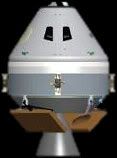
CREW EXPLORATION VEHICLE Update... By now, you should’ve all noticed that I’m currently interested in talking mostly about space-related stuff on my journal page, so here’s another space-related update! According to NASASpaceflight.com, engineers were having issues with the Crew Exploration Vehicle (CEV) in that it was 10,000 pounds overweight...meaning that the command and service modules (seen above) were too heavy for the solid rocket booster (the long white "stick" making up the bottom half of the vehicle, seen below) to handle during flight. In the process, engineers obviously began making changes to the CEV, and at the end, pulled off a remarkable feat of eliminating the excess 10,000 pounds from the spacecraft within a short amount of time. In fact, the CEV is now 100 pounds underweight! Sure, that amount is miniscule, but for engineers to be able to shed thousands of pounds from the launch vehicle—and then some—to make it work is astonishing. Again, go to NASASpaceflight.com for more details. (You’ll also see that the image I created below is also used in the CEV article on that website...but that’s not the reason why I decided to talk about the CEV on my page, haha. NSF webmaster Chris Bergin gave me credit for using that image.)
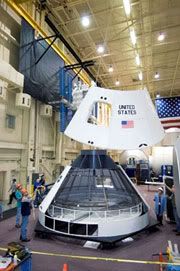
Engineers construct a mockup of the Crew Exploration Vehicle at NASA's Johnson Space Center in Houston, Texas (November, 2005).
In terms of naming the CEV, there have been rumors that NASA is close to choosing a name for the command and service modules [Not the Crew Launch Vehicle (the solid rocket booster and orange external fuel tank shown below)...that’s the Ares 1]. The name they’ve apparently selected is Orion. In case some of you are confusing Orion with NASA’s Constellation program (assuming at least some of you are space geeks like I am... Err, hopefully?), the Constellation program is the main organization that is responsible for the CEV project and all other missions supporting the Vision for Space Exploration effort (click here to read more about Constellation). Orion will be the name for all the actual missions...similar to the Mercury, Gemini and Apollo spaceflights. Go to Space.com for more details.
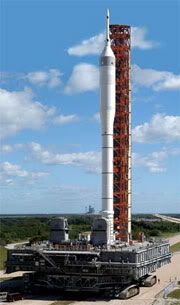
An early composite image of an Ares 1 test vehicle being rolled out to the launch pad in Cape Canaveral, Florida. The gray mobile platform that the craft is sitting on will be replaced with a newer, lighter transporter that will be able to move the CEV and its 4 million pounds worth of ground equipment to the launch area.
One last thing about the Crew Exploration Vehicle (for now)... As early as next April, one of the space shuttle launch pads will be transferred over to the Constellation program to begin modifications for Crew Launch Vehicle test flights (I’d mention when the test flights are suppose to take place, but that info came from a section of NASASpaceflight.com that is for paying members only). Operations from Launch Pad 39B—the pad from which the shuttle Discovery lifted off from about three weeks ago—will cease on March 31, 2007. All remaining shuttle missions will lift off from Launch Pad 39A...which as of this typing is undergoing an overhaul that will last for another six months. Click here for more details.

The Ares 1 rocket with the re-designed Crew Exploration Vehicle on top.
UPDATE #2: Well, it turns out that even though NASA has shed the 10,000 pounds that made the CEV/Crew Launch Vehicle overweight, there are other issues that the space agency still needs to deal with during this developmental phase of the program. The issues may be so numerous that NASA has an alternate look for the Ares 1 vehicle in case the current "stick" design doesn't work out...one that'll make it more closely resemble the space shuttle of today. However, this design has so far remained only a concept. Click here for more details.
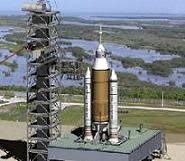
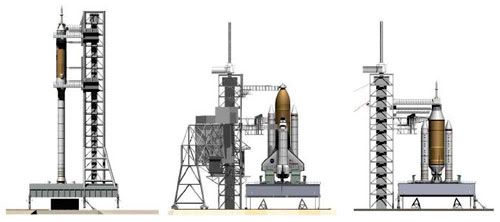
A comparison chart showing the size of the space shuttle relative to the current Ares
1 'Stick' (left) and the 'Stumpy' (right) design.

No comments:
Post a Comment